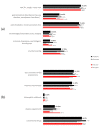Self-Medication Perceptions and Practice of Medical and Pharmacy Students in Serbia
- PMID: 35162213
- PMCID: PMC8834465
- DOI: 10.3390/ijerph19031193
Self-Medication Perceptions and Practice of Medical and Pharmacy Students in Serbia
Abstract
Background: Attitudes towards conventional and complementary medicine among future healthcare professionals can impact their future pharmacotherapy practice. This study aimed to determine the prevalence and predisposing factors related to self-medication among medical and pharmacy students.
Methods: This cross-sectional questionnaire-based study was performed at the Faculty of Medicine, University of Novi Sad, Serbia, on first- and final-year students of medicine and pharmacy. The multivariate Poisson regression model with robust variance was used to identify the main predictors of self-medication.
Results: The overall self-medication prevalence in the past year was 81.3%. Independent risk factors for self-medication identified in the regression analysis were the final study year, housing condition, i.e., living in a leased apartment or in a student dormitory in comparison to living with parents, and cigarette consumption. The conventional drugs were the most frequently used, mostly for the symptoms of cold and pain. Final-year students had more confidence in conventional medicines than in herbal drugs and were more aware of the risks of their concomitant use.
Conclusion: Self-medication is highly prevalent among students of medical sciences, especially among final-year students. Increased medical knowledge led to the higher awareness of the drug interaction risks.
Keywords: Serbia; herbal drugs; medical knowledge; pharmacy; self-medication; students.
Conflict of interest statement
The authors declare no conflict of interest.
Figures
Similar articles
-
Serbian students' knowledge, attitudes and behaviour towards antibiotic use: is there room for improvement?Int J Public Health. 2020 Nov;65(8):1257-1267. doi: 10.1007/s00038-020-01448-6. Epub 2020 Jul 31. Int J Public Health. 2020. PMID: 32737562
-
Intestinal microbiota, probiotics and their interactions with drugs: knowledge, attitudes and practices of health science students in Serbia.BMC Med Educ. 2024 Nov 27;24(1):1381. doi: 10.1186/s12909-024-06249-6. BMC Med Educ. 2024. PMID: 39605036 Free PMC article.
-
Self-medication among medical and pharmacy students in Bangladesh.BMC Res Notes. 2015 Dec 9;8:763. doi: 10.1186/s13104-015-1737-0. BMC Res Notes. 2015. PMID: 26652176 Free PMC article.
-
A cross-sectional survey: knowledge, attitudes, and practices of self-medication in medical and pharmacy students.BMC Health Serv Res. 2022 Mar 17;22(1):352. doi: 10.1186/s12913-022-07704-0. BMC Health Serv Res. 2022. PMID: 35300683 Free PMC article.
-
Prevalence of self-medication in university students: systematic review and meta-analysis.East Mediterr Health J. 2020 Jul 23;26(7):846-857. doi: 10.26719/emhj.20.052. East Mediterr Health J. 2020. PMID: 32794171
Cited by
-
Patterns and Prevalence of Self-Medication in Saudi Arabia: Insights From a Nationwide Survey.Cureus. 2023 Dec 29;15(12):e51281. doi: 10.7759/cureus.51281. eCollection 2023 Dec. Cureus. 2023. PMID: 38283451 Free PMC article.
-
Knowledge, Attitude, and Practice Towards Responsible Self-Medication Among Pharmacy Students: A Web-Based Cross-Sectional Survey in Uganda.Drug Healthc Patient Saf. 2025 Jan 7;17:7-23. doi: 10.2147/DHPS.S496924. eCollection 2025. Drug Healthc Patient Saf. 2025. PMID: 39802748 Free PMC article.
-
The pattern of self-medication practice among adult patients attending primary healthcare centers at NGHA in Riyadh, Saudi Arabia.J Family Med Prim Care. 2025 May;14(5):1741-1750. doi: 10.4103/jfmpc.jfmpc_1466_24. Epub 2025 May 31. J Family Med Prim Care. 2025. PMID: 40547751 Free PMC article.
-
Prevalence of self-medication among university students diagnosed with temporomandibular disorders.J Oral Facial Pain Headache. 2024 Sep;38(3):58-63. doi: 10.22514/jofph.2024.027. Epub 2024 Sep 12. J Oral Facial Pain Headache. 2024. PMID: 39800572 Free PMC article.
-
Understanding community pharmacists' intentions to report adverse drug reactions in Saudi Arabia: a theory of planned behavior analysis.Front Pharmacol. 2025 May 20;16:1574412. doi: 10.3389/fphar.2025.1574412. eCollection 2025. Front Pharmacol. 2025. PMID: 40463908 Free PMC article.
References
-
- World Health Organization . The Role of the Pharmacist in Self-Care and Self-Medication: Report of the 4th WHO Consultative Group on the Role of the Pharmacist, The Hague, The Netherlands, 26–28 August 1998. WHO; Geneva, Switzerland: 1998.
Publication types
MeSH terms
LinkOut - more resources
Full Text Sources
Miscellaneous



